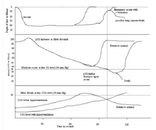This thread mixes two different topics: liquid breathing and breathing stimulus.
I am not aware of any connection between these two topics.
My knowledge of liquid breathing is very limited, indeed, not exceeding what one can learn on the wikipedia:
Liquid breathing - Wikipedia.
Instead I have some knowledge on methods for diminishing or entirely suppressing the breathing stimulus, as I was trained to free diving, back in the seventies.
At that time it was generally considered useful to teach free divers about these methods, which allow to extend the time spent breath holding.
But they also expose to serious risks of anoxy, which I experienced twice, passing out while training in a pool.
The breathing reflex can be suppressed acting on two factors:
1) reducing the amount of CO2 in the body by long and deep hyperventilation.
2) Increasing the threshold of CO2 concentration which triggers the reflex, by training the body to withstand progressively higher CO2 concentration (breath holding just after intense muscular efforts).
Albeit the two things require completely different, opposite training procedures, the end result is that a free diver is made capable of burning all the oxygen in his lungs before feeling the need to breath.
And this yields to passing out, which can be very dangerous if there is no proper surveilliance and fast rescue.




